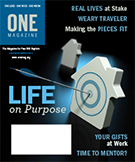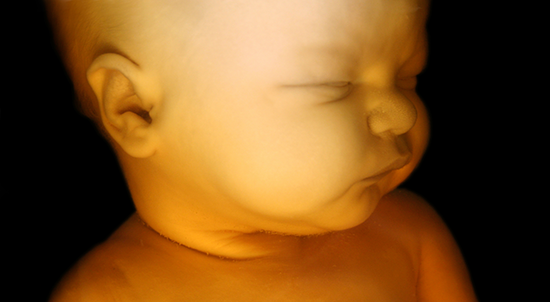
February-
March 2014
Life on Purpose
------------------
|

Real Lives at Stake
by Paul Harrison
Father’s Day Surprise
June 20, 2010, began as most Father’s Day Sundays had for the previous 20 years. I rose early, finished my sermon preparation, headed to church, and delivered God’s challenge to fathers to the best of my ability. The afternoon, however, proved to be different . . . life-altering in fact. Around three, the doorbell rang at our Nashville home, and we opened the door to find our son Andrew and his wife Laura had traveled from East Tennessee to surprise us. What a great Father’s Day gift!
But their presence, sweet as it was, was only the means of delivering an even more exciting message. Three days earlier, the two of them had rejoiced over a home test, and on that special day, Andrew and Laura presented me with…not a Father’s Day card but a Grandfather’s Day card. Needless to say, lots of hugging and crying occupied the rest of the afternoon. There’s nothing like becoming a parent or grandparent for the first time.
Unexpected Diagnosis
Laura had her first ultrasound July 6, and they experienced the wonder of seeing their little one’s pulsating heart. On September 14, they visited the doctor again to find out whether to buy blue or pink paint. Diane and I used the occasion as an excuse to make a run to Knoxville. We waited at their home and looked forward to more celebrating when they returned with the news.
I’ll never forget the looks on their faces as they entered the living room where we waited. They weren’t smiling. Their eyes were red and swollen. We didn’t know what the news was, but we knew it wasn’t good.
They learned their baby was a girl, but she had some serious issues. They had been given a list of possibilities, none encouraging: Down’s syndrome, heart trouble, bowel abnormalities, hydrocephalus, etc. Things still weren’t clear to the doctors, but testing had revealed enough to prompt them to begin preparing the parents for possible trouble. As our children sat on the couch, Andrew leaned over and hugged Laura’s little tummy, crying and promising to love their little girl, no matter what. Diane and I did our best to hold it together and to comfort them.
On October 5, 18 weeks into Laura’s pregnancy, she had another appointment for an anatomical scan of the baby. Diane and I headed to Knoxville again. We were all praying they would tell us the red flags were simply a false alarm.
It was not to be. Focused on the seriousness of the situation, a specialist took careful pictures of our granddaughter and zeroed in on the trouble areas. A genetic counselor explained that the baby’s brain ventricles were enlarged, an indication of hydrocephalus with the possibility of significant brain damage and all sorts of other scary things. She brought up the possibility of abortion.
A few minutes later they met with the specialist, and Diane and I were invited to join them as he presented his findings. He explained that the baby apparently had some sort of blockage that had caused spinal fluid to build up abnormally in her head. That buildup was limiting the development of the brain, and retardation would likely result. He explained that a shunt would have to be implanted surgically immediately after the baby’s birth to relieve the pressure. It would drain the spinal fluid into the abdominal cavity, where it would be absorbed.
Listening to the doctor, I had an idea. “Doctor, maybe Laura is just not far enough along yet for you to be able to see everything. Is it possible that what you’re seeing now will clear up?”
“No,” he replied quickly. “This is far enough along to have a good picture of the situation. This baby has severe hydrocephalus, and it won’t go away.”
Andrew had mentioned that we were all Christians, and I recall the doctor saying: “I also am a Christian, and I believe in miracles. I’ve never seen one, but I believe they are possible. I will say this: if this baby is born and doesn’t need a shunt, it would be a miracle.” He made it clear that hydrocephalus could result in minor or major brain issues, but the prognosis for this baby, he said, pointed toward severe problems.
Stunned hardly captures what we felt. We walked out of that office and drove home without knowing what to say or think. Andrew and Laura were going to be parents, and Diane and I were going to be grandparents, but it was clearly not going to be anything like we had imagined.
The Longest Wait
Months of waiting followed, months filled with prayer and adjustments to our thinking. While I prayed for the miracle the doctor spoke of, I sought to accept what the in utero pictures were showing and what the doctors were saying: our grandbaby and our children faced some heavy struggles. As the months passed, Andrew and Laura settled on a name: Charlotte Rose. We would call her Charlie.
Because of the pressure from the fluid on the head, hydrocephalic babies are delivered C-section. Charlie’s delivery was scheduled for February 15. A team of doctors would be there for her birth, after which she would be taken to the NICU. The next morning she would have a shunt surgically implanted at the children’s hospital across the street. Such was the plan.
The morning of the 15th arrived, and we made our way to the hospital. Andrew and Laura were hustled off to the delivery area, while the rest of us settled into the waiting room. At 11:21, Charlie was born. She weighed 8 pounds, 12 ounces and measured 21 inches long. Andrew could see the doctors looking at each other when she was born. They looked puzzled. They knew what hydrocephalic babies looked like, and Charlie didn’t fit the picture.
Soon, the whole family invaded the delivery room, and before our eyes we found a beautiful baby girl. As the hours unfolded, tests indicated that she indeed had enlarged ventricles, but she was not hydrocephalic. The shunt surgery was cancelled. Mom, dad, and a healthy Charlie went home on February 18, a miracle.
Living Miracle, Lasting Reminder
As I write this piece, Charlie is a vibrant two-year-old (pictured below). She is doing great, and there’s nothing grandpa and grandma love more than spending time with this precious little girl. I bounce her on my knee. I read books to her. I hold her little hand when we walk along. Praise God for my granddaughter!

I’ve narrated these traumatic events as a backdrop to the difficult subject of abortion. Usually when I deal with this topic, I discuss the philosophical and theological issues involved. The arguments against abortion are powerful. Overwhelmingly, it is only selfishness that argues for it.
Yet, while the arguments against abortion are important, they tend to be abstract, non-personal, and theoretical: When does life begin? What is personhood? But every day, Charlie reminds me that ultimately, abortion takes the life of a real person. If Andrew and Laura’s baby had been aborted as the doctor suggested, Charlie would have been killed. Not a theoretical person, but Charlie.
We may not like thinking about it, but the million plus babies we abort in America each year are real people: Charlies and Johns, Marys and Bills. They face death before being named, but each is a person, and I expect God knows their names even if no one else does. The waste of life is hard to comprehend.
We should also consider the impact on mothers who abort. I know the pressure to end a pregnancy can be intense. Poverty tells many a woman she can’t afford a baby. Shame over the exposure of an immoral sexual encounter also provides pressure for abortion, though this is declining with a 40% national non-marital birth rate. Still, parents and boyfriends often push for “taking care” of the pregnancy as a matter of convenience. A thousand arguments rise up and say abortion is the answer.
What is not said, I’m afraid, is that the trauma of abortion will remain with the woman for the rest of her life. She will forever know what she’s done, if no one else knows. As the years pass, she’ll think of how old her child would have been. She’ll see her son or daughter’s face reflected in young people she meets. Abortion comes with a price, and that price will be paid.
The movie October Baby came out in 2011. It tells the story of an abortion and its impact on several lives. The mother is well played by Shari Rigby, whose character struggles to come to terms with what she did as a young woman. When offered the part, Rigby called the producers and, amazingly, admitted she had “taken care of” an unplanned pregnancy in real life, many years before. She wanted the part, believing it was God’s way of helping her make amends. God helped her find healing after years of suffering. Pain goes along with abortion in more ways than one.
Making Life Count
Here in Nashville every year, Aquinas College displays small white crosses on their campus to emphasize the vast number of lives lost through abortion. When you drive by, you are confronted with a sea of crosses splashed across many acres of lawn. It’s a profound visual reminder of the millions of babies lost to abortion. The truth is, however, that there should also be a “mother” cross and a “father” cross for every “baby” cross. When a mother and father carry the knowledge of what they’ve done to their own baby, how can anyone calculate the impact on their souls? Thank God for His forgiveness, but the impact of such a sin is hard to shake.
This is true also of all of us and our society at large. When we stand by silently in the face of such horrors, how can it not deaden our hearts to love and compassion? Abortion has a hidden moral price tag, and it is more than we can imagine. Only time will reveal its total cost. We must never forget that in the debate over abortion, real lives are at stake.
About the Writer: Paul Harrison served as pastor of Cross Timbers FWB Church in Nashville, Tennessee, from 1991 to 2013. He also served as adjunct professor at Welch College for 17 years, teaching church history and Greek. Paul and his wife Diane have two sons and a granddaughter…Charlie.
Absence of
Mourning
By Paul V. Harrison
When topped with gray in nature’s time
One leaves our arms and earth’s sweet clime
To breathe the air of life beyond,
We grieve and mourn the broken bond.
When younger ones in life’s midstream
Shed flesh and blood for heaven’s dreams,
The less sand passed the more the grief;
Our tears flow long when life is brief.
Then how, when hearts have just begun,
When limbs have never walked nor run,
Can death be sought, take eyes and voice,
And humans nod and call it choice?
|
|

